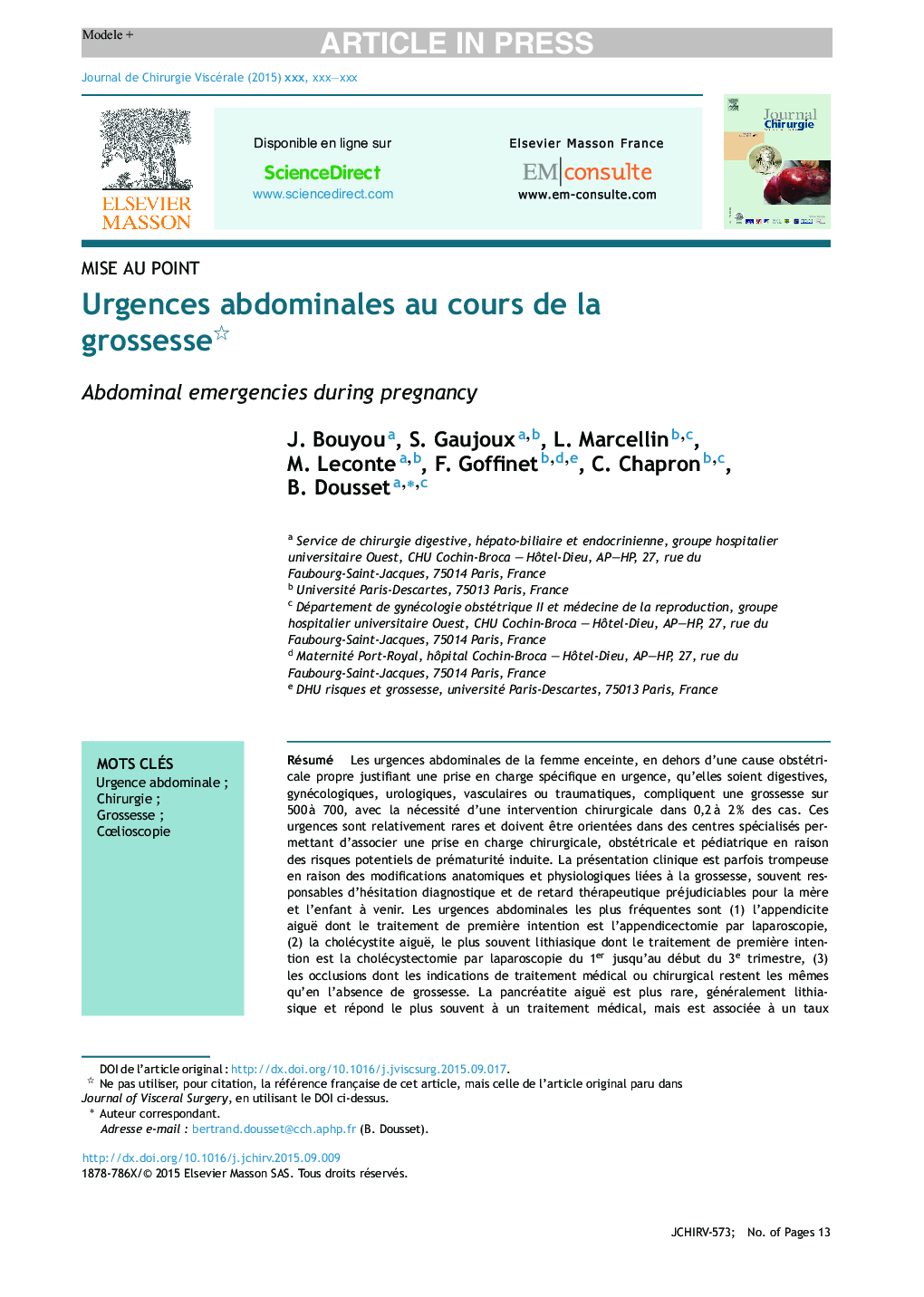| کد مقاله | کد نشریه | سال انتشار | مقاله انگلیسی | نسخه تمام متن |
|---|---|---|---|---|
| 3311801 | 1210978 | 2015 | 13 صفحه PDF | دانلود رایگان |
عنوان انگلیسی مقاله ISI
Urgences abdominales au cours de la grossesse
ترجمه فارسی عنوان
موارد اضطراری شکمی در دوران بارداری
دانلود مقاله + سفارش ترجمه
دانلود مقاله ISI انگلیسی
رایگان برای ایرانیان
کلمات کلیدی
ترجمه چکیده
موارد اضطراری شکمی در دوران بارداری (به استثنای شرایط اورژانسی مامایی) در یکی از بارداری های 500-700 اتفاق می افتد و ممکن است شامل علل گوارشی، جراحی، ارولوژی، عروقی و آسیب شناسی باشد؛ جراحی در 2-2٪ موارد ضروری است. از آنجایی که این موارد اضطراری نسبتا نادر هستند، بیماران باید به مراکز تخصصی مراجعه کنند که مراقبت های جراحی، مامایی و نوزادان در دسترس هستند، به خصوص به این دلیل که مداخله جراحی باعث افزایش خطر ابتلا به زودرس می شود. ارائه بالینی ممکن است غیر معمول و گمراه کننده به دلیل تغییرات تشریحی و فیزیولوژیک مرتبط با بارداری است که اغلب به عدم قطعیت تشخیصی و تاخیر درمانی با افزایش خطر بیماری های مادر و نوزاد کمک می کند. شایع ترین موارد اضطراری شکمی آپاندیسیت حاد است (بهترین درمان با آپاندکتومی لاپاروسکوپی)، کولسیستیت فاکتور حاد (بهترین درمان با کولسیستکتومی لاپاروسکوپی از سه ماهه ی اول تا اواسط سه ماهه ی سوم) و انسداد روده ( خط روانی، درست مثل بیمار غیر باردار). پانکراتیت حاد نادر است، معمولا ناشی از عبور آمپولاری سنگ صفراوی است؛ آن معمولا با درمان پزشکی حل می شود، اما خطر بالایی از وقایع عودکننده، کولسیستکتومی لاپاروسکوپی در سه ماهه دوم و سوماتیک تناسلی آندوسکوپی در سه ماهه سوم را توجیه می کند. هدف از این مقاله، بررسی تغییرات تشریحی و فیزیولوژیک ناشی از بارداری، توصیف شرایط اضطراری اصلی شکم در دوران بارداری، ویژگی های خاص آنها و مدیریت تشخیصی و درمانی آنها می باشد.
موضوعات مرتبط
علوم پزشکی و سلامت
پزشکی و دندانپزشکی
بیماریهای گوارشی
چکیده انگلیسی
Abdominal emergencies during pregnancy (excluding obstetrical emergencies) occur in one out of 500-700 pregnancies and may involve gastrointestinal, gynecologic, urologic, vascular, and traumatic etiologies; surgery is necessary in 0.2-2% of cases. Since these emergencies are relatively rare, patients should be referred to specialized centers where surgical, obstetrical, and neonatal care are available, particularly because surgical intervention increases the risk of premature labor. Clinical presentations may be atypical and misleading because of pregnancy-associated anatomical and physiologic alterations, which often result in diagnostic uncertainty and therapeutic delay with increased risks of maternal and infant morbidity. The most common abdominal emergencies are acute appendicitis (best treated by laparoscopic appendectomy), acute calculous cholecystitis (best treated by laparoscopic cholecystectomy from the first trimester through the early part of the third trimester), and intestinal obstruction (where medical treatment is the first-line approach, just as in the non-pregnant patient). Acute pancreatitis is rare, usually resulting from trans-ampullary passage of gallstones; it usually resolves with medical treatment but an elevated risk of recurrent episodes justifies laparoscopic cholecystectomy in the 2nd trimester and endoscopic sphincterotomy in the 3rd trimester. The aim of the present work is to review pregnancy-induced anatomical and physiological modifications, to describe the main abdominal emergencies during pregnancy, their specific features, and their diagnostic and therapeutic management.
ناشر
Database: Elsevier - ScienceDirect (ساینس دایرکت)
Journal: Journal de Chirurgie Viscérale - Volume 152, Issue 6, Supplement, December 2015, Pages S50-S62
Journal: Journal de Chirurgie Viscérale - Volume 152, Issue 6, Supplement, December 2015, Pages S50-S62
نویسندگان
J. Bouyou, S. Gaujoux, L. Marcellin, M. Leconte, F. Goffinet, C. Chapron, B. Dousset,
